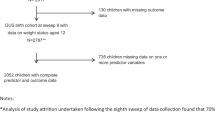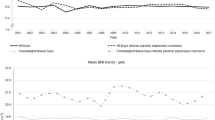Abstract
Background:
Pediatric obesity prevalence remains at historically high levels. The objective of this study was to examine secular trends in the percentages of overweight/obese children who received notification from a health-care professional (HCP) about their unhealthy weight.
Methods:
We analyzed data of 25 570 (including 8639 overweight/obese) children aged 2–18 years collected from seven cross-sectional biennial surveys (National Health and Nutrition Examination Survey, 1999–2014), in which adolescents (16 years and older) and caregivers, mostly biological mothers, of children (2–15 years) were asked 'Has a doctor or other health professional ever told you that you (or your child) were overweight?'
Results:
Approximately 90% of overweight/obese children visited HCPs at least once in the past 12 months, but only 22.12% (s.e.=1.92) in 1999 to 34.43% (2.35) in 2014 of the overweight/obese children were notified by HCPs about unhealthy weight. The biennial increase in odds of receipt of notification of unhealthy weight was 1.08 (95% confidence interval=(1.04–1.12)). Greater likelihood for receipt of notification was associated with being obese (odds ratio=5.03 (4.29–5.89) vs overweight); black (1.24 (1.06–1.46)) or Hispanic race/ethnicity (1.72 (1.45–2.04) vs white); female sex (1.22 (1.07–1.11) vs boys); and child’s insurance status (1.31 (1.08–1.59) vs uninsured). There were increasing odds of being notified with increasing age: 1.00 (reference), 2.24 (2.06–2.62), 3.22 (2.50–4.13) and 4.87 (3.76–6.32) for children 2–5, 6–11, 12–16 and 16+ year old, respectively. The frequency of medical contact was linearly associated with an increased likelihood of being notified.
Conclusions:
Notification of child’s unhealthy weight by HCPs increased significantly between 1999 and 2014, but the opportunity of clinical intervention remained substantially under-utilized.
This is a preview of subscription content, access via your institution
Access options
Subscribe to this journal
Receive 12 print issues and online access
$259.00 per year
only $21.58 per issue
Buy this article
- Purchase on Springer Link
- Instant access to full article PDF
Prices may be subject to local taxes which are calculated during checkout



Similar content being viewed by others
References
Ogden CL, Carroll MD, Kit BK, Flegal KM . Prevalence of obesity and trends in body mass index among US children and adolescents, 1999-2010. JAMA 2012; 307: 483–490.
McMullen S . Childhood obesity: the impact on long-term risk of metabolic and CVD is not necessarily inevitable. Proc Nutr Soc 2014; 73: 389–396.
Hansen AR, Duncan DT, Tarasenko YN, Yan F, Zhang J . Generational shift in parental perceptions of overweight among school-aged children. Pediatrics 2014; 134: 481–488.
Duncan DT, Hansen AR, Wang W, Yan F, Zhang J . Change in misperception of child's body weight among parents of American preschool children. Child Obes 2015; 11: 384–393.
Lu H, Tarasenko YN, sgari-Majd FC, Cottrell-Daniels C, Yan F, Zhang J . More overweight adolescents think they are just fine: generational shift in body weight perceptions among adolescents in the U.S. Am J Prev Med 2015; 49: 670–677.
Barlow SE, Dietz WH . Obesity evaluation and treatment: Expert Committee recommendations. The Maternal and Child Health Bureau, Health Resources and Services Administration and the Department of Health and Human Services. Pediatrics 1998; 102: E29.
Kant AK, Miner P . Physician advice about being overweight: association with self-reported weight loss, dietary, and physical activity behaviors of US adolescents in the National Health and Nutrition Examination Survey, 1999-2002. Pediatrics 2007; 119: e142–e147.
Dilley KJ, Martin LA, Sullivan C, Seshadri R, Binns HJ . Identification of overweight status is associated with higher rates of screening for comorbidities of overweight in pediatric primary care practice. Pediatrics 2007; 119: e148–e155.
Barlow SE, Bobra SR, Elliott MB, Brownson RC, Haire-Joshu D . Recognition of childhood overweight during health supervision visits: Does BMI help pediatricians? Obesity (Silver Spring) 2007; 15: 225–232.
Kelly AS, Barlow SE, Rao G, Inge TH, Hayman LL, Steinberger J et al. Severe obesity in children and adolescents: identification, associated health risks, and treatment approaches: a scientific statement from the American Heart Association. Circulation 2013; 128: 1689–1712.
Klein JD, Sesselberg TS, Johnson MS, O'Connor KG, Cook S, Coon M et al. Adoption of body mass index guidelines for screening and counseling in pediatric practice. Pediatrics 2010; 125: 265–272.
Gaffney KF, Kitsantas P, Brito A, Kastello J . Baby steps in the prevention of childhood obesity: IOM guidelines for pediatric practice. J Pediatr Nurs 2014; 29: 108–113.
NAPNAP. NAPNAP position statement on the identification and prevention of overweight and obesity in the pediatric population. J Pediatr Health Care 2009; 23: A15–A16.
Krebs NF, Jacobson MS . Prevention of pediatric overweight and obesity. Pediatrics 2003; 112: 424–430.
Walsh CO, Milliren CE, Feldman HA, Taveras EM . Sensitivity and specificity of obesity diagnosis in pediatric ambulatory care in the United States. Clin Pediatr (Phila) 2013; 52: 829–835.
Perrin EM, Skinner AC, Steiner MJ . Parental recall of doctor communication of weight status: national trends from 1999 through 2008. Arch Pediatr Adolesc Med 2012; 166: 317–322.
Patel AI, Madsen KA, Maselli JH, Cabana MD, Stafford RS, Hersh AL . Underdiagnosis of pediatric obesity during outpatient preventive care visits. Acad Pediatr 2010; 10: 405–409.
Hillman JB, Corathers SD, Wilson SE . Pediatricians and screening for obesity with body mass index: does level of training matter? Public Health Rep 2009; 124: 561–567.
Benson L, Baer HJ, Kaelber DC . Trends in the diagnosis of overweight and obesity in children and adolescents: 1999-2007. Pediatrics 2009; 123: e153–e158.
Gilbert MJ, Fleming MF . Use of enhanced body mass index charts during the pediatric health supervision visit increases physician recognition of overweight patients. Clin Pediatr (Phila) 2007; 46: 689–697.
Dorsey KB, Wells C, Krumholz HM, Concato J . Diagnosis, evaluation, and treatment of childhood obesity in pediatric practice. Arch Pediatr Adolesc Med 2005; 159: 632–638.
Barlow SE . Expert committee recommendations regarding the prevention, assessment, and treatment of child and adolescent overweight and obesity: summary report. Pediatrics 2007; 120: S164–S192.
Centers for Disease Control and Prevention. A SAS Program for the CDC Growth Charts. Available at: http://www.cdc.gov/nchs/nhanes/about_nhanes.htm (accessed on 07 June 2012).
Krebs NF, Himes JH, Jacobson D, Nicklas TA, Guilday P, Styne D . Assessment of child and adolescent overweight and obesity. Pediatrics 2007; 120: S193–S228.
Koplan JP, Liverman CT, Kraak VI . Preventing childhood obesity: health in the balance: executive summary. J Am Diet Assoc 2005; 105: 131–138.
Flegal KM, Wei R, Ogden CL, Freedman DS, Johnson CL, Curtin LR . Characterizing extreme values of body mass index-for-age by using the 2000 Centers for Disease Control and Prevention growth charts. Am J Clin Nutr 2009; 90: 1314–1320.
Truman BI, Smith KC, Roy K, Chen Z, Moonesinghe R, Zhu J et al. Rationale for regular reporting on health disparities and inequalities - United States. MMWR Surveill Summ 2011; 60: 3–10.
Yaemsiri S, Slining MM, Agarwal SK . Perceived weight status, overweight diagnosis, and weight control among US adults: the NHANES 2003-2008 Study. Int J Obes (Lond) 2011; 35: 1063–1070.
Davis NJ, Wildman RP, Forbes BF, Schechter CB . Trends and disparities in provider diagnosis of overweight analysis of NHANES 1999-2004. Obesity (Silver Spring) 2009; 17: 2110–2113.
Whitaker RC, Wright JA, Pepe MS, Seidel KD, Dietz WH . Predicting obesity in young adulthood from childhood and parental obesity. N Engl J Med 1997; 337: 869–873.
Rhee KE, De Lago CW, rscott-Mills T, Mehta SD, Davis RK . Factors associated with parental readiness to make changes for overweight children. Pediatrics 2005; 116: e94–101.
Grimmett C, Croker H, Carnell S, Wardle J . Telling parents their child's weight status: psychological impact of a weight-screening program. Pediatrics 2008; 122: e682–e688.
Abid A, Galuska D, Khan LK, Gillespie C, Ford ES, Serdula MK . Are healthcare professionals advising obese patients to lose weight? A trend analysis. MedGenMed 2005; 7: 10.
Galuska DA, Will JC, Serdula MK, Ford ES . Are health care professionals advising obese patients to lose weight? JAMA 1999; 282: 1576–1578.
Hamilton JL, James FW, Bazargan M . Provider practice, overweight and associated risk variables among children from a multi-ethnic underserved community. J Natl Med Assoc 2003; 95: 441–448.
Luckhaupt SE, Cohen MA, Li J, Calvert GM . Prevalence of obesity among U.S. workers and associations with occupational factors. Am J Prev Med 2014; 46: 237–248.
Han K, Trinkoff AM, Storr CL, Geiger-Brown J . Job stress and work schedules in relation to nurse obesity. J Nurs Adm 2011; 41: 488–495.
Jackson JE, Doescher MP, Saver BG, Hart LG . Trends in professional advice to lose weight among obese adults, 1994 to 2000. J Gen Intern Med 2005; 20: 814–818.
Centers for Disease Control and Prevention (CDC). Children and teens told by doctors that they were overweight—United States, 1999-2002. MMWR Morb Mortal Wkly Rep 2005; 54: 848–849.
Wisemandle W, Maynard LM, Guo SS, Siervogel RM . Childhood weight, stature, and body mass index among never overweight, early-onset overweight, and late-onset overweight groups. Pediatrics 2000; 106: E14.
Borra ST, Kelly L, Shirreffs MB, Neville K, Geiger CJ . Developing health messages: qualitative studies with children, parents, and teachers help identify communications opportunities for healthful lifestyles and the prevention of obesity. J Am Diet Assoc 2003; 103: 721–728.
Guo SS, Roche AF, Chumlea WC, Gardner JD, Siervogel RM . The predictive value of childhood body mass index values for overweight at age 35 y. Am J Clin Nutr 1994; 59: 810–819.
Loureiro ML, Nayga RM Jr . Obesity, weight loss, and physician's advice. Soc Sci Med 2006; 62: 2458–2468.
Stafford RS, Farhat JH, Misra B, Schoenfeld DA . National patterns of physician activities related to obesity management. Arch Fam Med 2000; 9: 631–638.
Acknowledgements
Dr Zhang conceived of and designed the study, acquired and interpreted the data, and critically revised it. Drs Zhang, Hansen and Duncan had full access to all of the data in the study, take responsibility for the integrity of the data and the accuracy of the data analysis; Drs Hansen, Duncan and Woo Baidal assisted in designing, analyzing and interpreting the data, drafting manuscript and critically revising the manuscript. Ms Hill and Turner analyzed the data and drafted the article. We thank Mr James Williams and John Twarog for commenting on an earlier version of this manuscript. The project was done with no specific support. Parts of the results were submitted by Ashley Hill and Suzi Turner in partial fulfillment of the requirements for their degrees in Master of Public Health.
Author information
Authors and Affiliations
Corresponding author
Ethics declarations
Competing interests
The authors declare no conflict of interest.
Additional information
Supplementary Information accompanies this paper on International Journal of Obesity website
Supplementary information
Rights and permissions
About this article
Cite this article
Hansen, A., Duncan, D., Woo Baidal, J. et al. An increasing trend in health-care professionals notifying children of unhealthy weight status: NHANES 1999–2014. Int J Obes 40, 1480–1485 (2016). https://doi.org/10.1038/ijo.2016.85
Received:
Revised:
Accepted:
Published:
Issue Date:
DOI: https://doi.org/10.1038/ijo.2016.85
This article is cited by
-
Does dissatisfaction with, or accurate perception of overweight status help people reduce weight? Longitudinal study of Australian adults
BMC Public Health (2019)
-
Adolescent preferences and reactions to language about body weight
International Journal of Obesity (2017)
-
Telling people they are overweight: helpful, harmful or beside the point?
International Journal of Obesity (2017)



